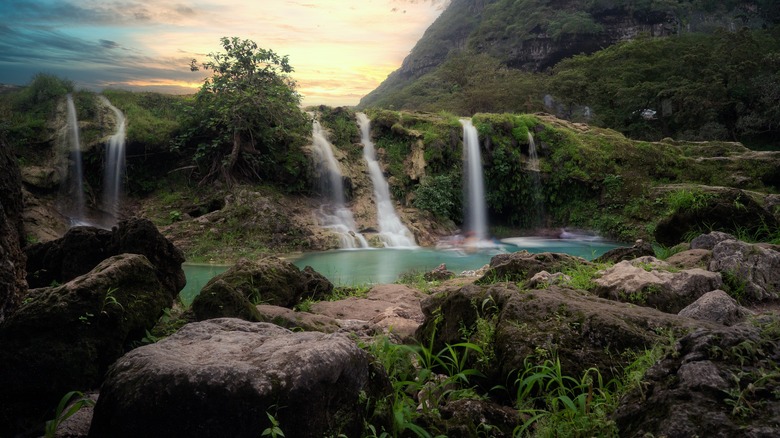Escape Crowds At This Tourist-Friendly Arabian Sea Paradise
Known for its impressive coastline and jaw-dropping waterfalls, Salalah — the capital of the Dhofar region in Oman — is a traveler's hidden paradise full of stunning natural wonders. Nestled along the Arabian Sea and not far from the border to neighboring Yemen, Salalah has a deeply rooted history that stretches back all the way to the first century when the Al Hadhrami Kingdom ruled much of the region. With its trove of frankincense trees and native spices, Salalah quickly became a significant strategic trade location for international merchants traversing the Arabian Sea. In modern times, the city served as the governing seat of the reigning Omani sultan from 1932 until 1970.
In contrast with the stark desert landscapes throughout the rest of the Arabian Gulf, Salalah is renowned as an idyllic tropical haven, courtesy of the seasonal khareef (or "monsoon") that lasts from June through September. These months also mark the time when the large-scale Salalah Tourism Festival commences, drawing in a number of Omani citizens to celebrate with a variety of engaging activities, from local concerts to children's amusement rides. Similar to the Cambodian islands of Koh Rong, which are renowned as a leader in sustainable tourism, Salalah has also invested a great deal of resources into eco-tourism.
Dive into Salalah's azure waters and natural springs
Salalah offers visitors a level of exotic beauty unlike any other destination in the region. To the west of the city lies the popular yet relatively untouched Al-Mughsail Beach, with its distinctive rocky coastline, iridescent blue waters, and famous blowholes that visitors can watch from Marneef Cave. During the khareef, kelp forests emerge within the nearby coral reefs, teeming with vibrant marine life, from sea turtles to manta rays. However, these reefs are quite sheltered, so beginner divers should have some degree of professional training to ensure the habitats remain untouched.
A series of otherworldly waterfalls are also located near Salalah, including Ain Athum and Wadi Darbat. The latter of which is classified as a UNESCO World Heritage Site, where hikers are rewarded from their trek with refreshing isolated pools ensconced by the cascading falls and effervescent frankincense trees. Travelers should also make the time to journey to Ain Razat, one of Dhofar's more prominent natural springs bordered by an ethereal valley with an immense cavern to explore.
For those that are looking for a rugged, off-the-beaten-path adventure, the nature sanctuary Jabal Samhan offers the perfect opportunity. As an expansive mountainous terrain rich in biodiversity, travelers are sure to encounter an assortment of spectacular wildlife, such as deer, reptiles, and Arabian leopards. After a long day of trekking throughout the craggy sanctuary, hikers are rewarded after setting up camp with a breathtaking panoramic view of the star-speckled night sky.
Immerse yourself in Salalah's rich archeological history
The only thing that can match the magnitude and wonder of Salalah's natural vistas is its wealth of archeological sites. The city's numerous historical landmarks and museums provide a distinctive glimpse into the illustrious past of Oman that stretches back thousands of years. To some extent, Salalah acts as a remote oasis for ancient Middle Eastern history. As a UNESCO World Heritage site, Al Baleed Archeological Park contains the ruins of the once flourishing port city of Zafar. Visitors can explore the remains of the Grand Mosque and the Museum of the Land of Frankincense, which chronicle the global, economic, and cultural impact of the highly valuable resin.
About 20 miles outside of the city stands Taqah Castle, a magnificent palace with imposing spires. It was once the extravagant residence of Sheikh Ali bin Taman and is now a museum preserving Omani relics and antiquities. Pilgrims of Islam, Christianity, and Judaism also congregated to pay their respects at the Tomb of Nabi Ayub (also known as the Prophet Job) which rests atop the rocky crests overlooking the city.
You can also swing by Mirbat, a smaller coastal town to the east of Salalah known for its heritage in horse breeding and trading. While enjoying the local markets showcasing the works of local artisans, you can explore plenty of landmarks, such as the Mirbat Fort and the ruins of Khor Rori, which illustrate just how much this isolated tropical paradise shaped the ancient Arabian world. Salalah is just one of the many vacation destinations you must see at least once in your life.


